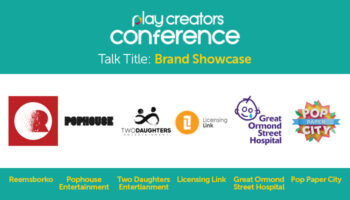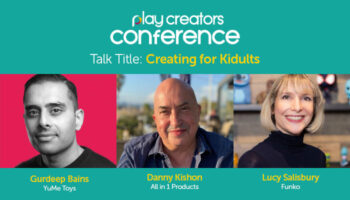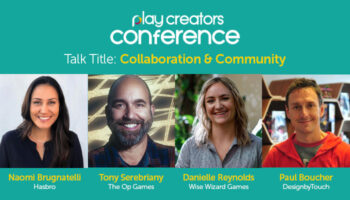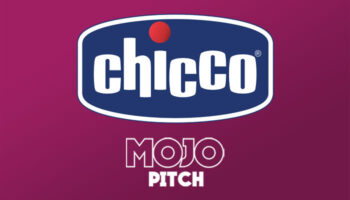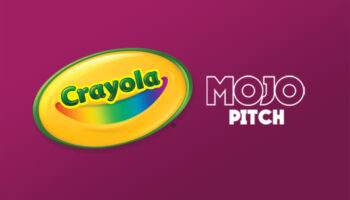AMIGO’s Anna-Lena Heid reveals two things EVERY inventor should bring when they pitch to her…

Alrighty! Anna-Lena, Editor at AMIGO! I’m surprised we haven’t pulled out the chair for you before; thanks for joining us.
Thanks for having me, Deej!
Let’s kick off gently… When you were growing up, what were your favourite toys and games?
Oh dear…
Oh dear?! Now I’m worried! I saw that as an easy one!
Ha! The trouble is that I was enthusiastic about pretty much everything as a child. The fact that my mother worked in a shop for games, toys and school supplies at the time didn’t really help. So there was actually not ONE favourite game or toy.
I see – too many options…
Right. It’s tough to choose, but there were a couple of highlights… When it comes to toys, my pride and joy in my early childhood was a DUPLO electric train that chugged around seemingly non-stop. I remember vividly, how the winding tracks and surreal brick-buildings have turned my room into a veritable obstacle course.

Lovely.
Regarding children’s games, I have fond memories of Max Mümmelmann and Clown, both Ravensburger. They’re the first games I can remember. They were followed a little later by my first AMIGO game, the classic and beloved Halli Galli. All of these are very worn out by now, but for nostalgic reasons I still have them!
Fantastic. I’m always disappointed to hear people have fond memories of things but that they gave them away years ago. And how about now, Anna-Lena? What kind of things do you appreciate today?
Actually, it’s still the same: I don’t have one favourite game. It always depends on the situation, the group, and what I’m in the mood for. At the moment, I very much enjoy games in which I can ponder and puzzle.
Can you give me an example?
Sure! I was very surprised by Voll verplant from Schmidt Spiele in this respect. I play that a lot at the moment. I really like Roll-and-Writes, or Flip-and-Writes, anyway… We’re also playing Calico by Flatout Games pretty often currently – partly because I love Beth Sobel’s illustrations so much. And then there are cats as well – fantastic! Fun fact: my cat Mumin looks like a cross between Coconut and Millie.

Coconut and Millie. This is all going in the notebook. What is it, then, that you look for in a game; what unites your favourites?
What always works for me and my family are card games. It’s no coincidence that I work for AMIGO of all places! Games like Wizard, 6 nimmt! and Bohnanza have been on our table regularly for years. Our copy of L.A.M.A. – L.L.A.M.A. in English – clearly shows signs of use. It’s become a real family classic and is played at every opportunity. Closely followed by Krass kariert – Dealt! in English. That’s one of the best AMIGO games, in my opinion. But in principle, I’m up for almost anything from simple card or dice games to family games and more complex strategy games. And I’m always happy to get to know new games!
It certainly feels like you’ve found your vocation, then! So what’s your background? How did you get into the toy and game industry?
I’m quite a newbie. Ever since I was a child, I had two great passions: games and books. Before I entered the games industry, in June last year, I was involved in the latter. I organised author readings while studying German and English literary and cultural studies. Afterwards, I worked in the events department of a renowned book publisher. But I never really lost sight of the idea of turning my other great hobby into a profession.
Interesting. How did it happen? What was the catalyst for change?
Covid appeared on the scene! That turned everything upside down. It made me reflect a lot, and I felt like ‘now or never’. I guess that was because it’s easier to enter uncharted territory when everything around you seems somehow uncertain anyway.

Hm. Yes. I think that’s true for a lot of people.
At least that’s how it was for me. So, I didn’t hesitate for long and took the initiative and applied to AMIGO as trainee in the editorial department. The choice of publisher was not at all difficult for me. A look at the undeniable dominance of AMIGO games on my game shelf provided a pretty clear answer to the question of which publisher would be the best match for me. And what can I say? It all worked out, which I’m very happy about!
I love that! I love that you picked which company to approach based on the love you have for their games. And speaking of AMIGO, the company recently signed up to the Mojo Nation pitch event. Thanks! What do you most want to get out of it?
I’m excited to meet many new game designers and get to know their ideas. It’s awesome that the event is taking place live, after such a long time of online meetings. Don’t get me wrong, video conferencing has its benefits, too. But it’s really something different to sit face-to-face, talk, and try out a game in person. If a future AMIGO game were to be included in the pitches, that would of course be the icing on the cake.
In that respect, what can we tell inventors so that they can start giving thought to what makes Amigo products special? What qualities do you look for in an idea?
There are many factors helping us decide whether a game fits in our range or not. A first point of reference for any inventor wanting to present a game to us is our ‘Information for new game developers’ document.

Oh! There’s a document people can look at in advance? Can we put a link to that the end of the interview?
Absolutely! The document shows important data, useful information on the general procedure and a few other hints that provide a good starting point. Concerning the specific qualities, I’d state that AMIGO games are games for the whole family. They’re easy to learn, quick to play and bring lots of fun. They’re not too complex, and rather compact when it comes to material and boxes – but still have a great depth and high replayability. The games also see players having a profound influence on the outcome.
A profound influence on the outcome? In what way?
Well, although a bit of luck is always involved, players win through good play, or clever play… Interaction and emotions are just as important as the smart ‘twist’ that makes a game special and unique. We generally look for children’s and family games, and especially card games.
Great stuff. Conversely, what are the red lines? What qualities do you not want to see?
We’re not the right partner when it comes to abstract thinking games or complex strategy games. If it takes hours to read and understand the rules or to play the game itself, it is, for sure, not a fit for us. Also, in terms of material expenditure we’re fans of keeping it simple and we especially try to avoid plastic whenever possible. Neither are we looking for games for only one or two players, party games or quiz games.

Noted. That’s great…
Again, it’s worth taking a look at our Information for New Game Developers for further information, as well as a comprehensive list of game types that we are not looking for.
In terms of having people pitch to you, is there anything you like inventors to do in advance?
Before the pitch, there’s one thing EVERY inventor should do: familiarise themselves with the product line of the corresponding publisher… That’s the only way to find out whether we’re the right publisher for their game or not.
And is there a structure you prefer during the pitch itself?
No, I don’t have a preferred pitching structure. That said, it’s always extremely helpful to have the key data of the game right at the beginning for a broad overview…
Just so we’re all on the same page, how would you define key data?
How many players can participate? How long does a game take? What’s the age recommendation? What type of game is it? What are the key mechanics? Are there games you’d compare it to – with regards to complexity, feel, and so on? Which materials or components are needed? It’s also turned out very useful to have a brief summary of the basic idea, the goal of the game and how it’s achieved before explaining in detail how the game works.

Like nesting dolls? A chunking down approach…
Yes, that makes it much easier to follow. Also when describing the gameplay, inventors should make sure to focus on two things: the basics – not some special rule that rarely occurs – and the distinctive features, the game’s USP. These are the cornerstones that should convince me to take the game with me.
I’m loving this. I’ll ask a couple more pitching questions because I know to be forewarned is to be forearmed! So… What’s the one thing every inventor should bring into the room when they meet you?
Do you want the cheesy answer or the boring one?
Ha! I want both! I’ll rephrase the question: what’re the two things every inventor should bring into the room when they meet you?
The boring one is a sell sheet – including contact details. Providing me with this info means I can spend more brainpower listening and understanding the game than if I have to take many notes.

So an old-school sell sheet… You know, as I say that out loud, I’m not sure we’ve done an article on sell sheets. We should. That’d be useful. Okay… And the cheesy one?
The cheesy one… Good spirits! We’re working on games! That’s fun!
Perfect. I’ll ask one more question about pitching, in relation to following up on interesting concepts… How do you tend to work there? How do you progress things after a pitch?
To keep a long process short: if we like a game, we’ll request a playable sample; a prototype. Then there’ll be a lot of playtesting of the prototype: mainly within the editorial team, but also in external test groups. If, after all this testing, we still like the game, we schedule a meeting with our management board, who’ll play it themselves.
AMIGO’s management playtest every game personally?
Well, not every prototype we’re receiving, of course! But all those that we, in the editorial team, have ‘preselected’ until then, and recommend for publication. These prototypes they play, then they make a decision as to whether AMIGO will publish the game or not. Throughout the whole process – which often takes six months or more – we’re always keen to keep inventors informed, and provide feedback whenever there’s something new to report.

Fantastic. This has been brilliant Anna-Lena. I’ll definitely include a link to that document at the end, but let’s wrap it up with one last question… What’s the most interesting thing in your office?
We’re nurturing a Cthulhu in our office. Well, actually it’s just an aloe vera plant. Cthulhu is still resting in his death-like sleep – but we’re doing our best not to let him really die!
This has taken a surreal and gloomy turn, right at the last question!
Ha! Things are less gloomy in our L.A.M.A. parade, with L.A.M.A.’s from all over the world. Whenever another export version is released, it becomes trickier not to let the parade turn into a domino disaster.
Brilliant. Thank you again Anna-Lena. Adam will work his magic and insert the link here. He’ll probably make the word HERE a link. And if I keep saying HERE, I’ve got a feeling he’ll make every use of the word here a link!

–
To stay in the loop with the latest news, interviews and features from the world of toy and game design, sign up to our weekly newsletter here



